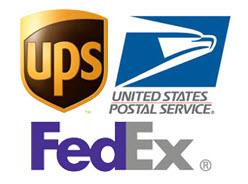
Will USPS rate hike drive online sellers to consider FedEx and UPS? EcommerceBytes spoke to several shipping analysts about the challenges shippers are facing across the board as carriers try to improve their revenue per shipment. Here’s what they had to say, including advice on how to make the right decision about which carrier to consider for your online order fulfillment.
If the U.S. Postal Service gets its way, it’s going to cost a lot more to send packages next year.
But those shipping increases, painful as they may be, aren’t likely to send online sellers scrambling to commercial carriers like UPS and FedEx.
That’s because those carriers are both raising rates next year by nearly 6 percent, but within that headline number lie significant pricing variations that could drive costs even higher for sellers using certain shipping classes, as well as other variables like package dimension and shipping zone.
“Regrettably for shippers, the USPS isn’t the only one increasing their rates,” Josh Dunham, CEO of the shipping consultancy Reveel, said in an email. “Both FedEx and UPS announced a 5.9 percent general rate increase for 2022.”
Reveel conducted an analysis of the commercial carriers’ rate increases, modeling what its customers’ spending over the past year would look like under the new rates. More than 97 percent of shippers would see their rates increase by more than the general 5.9 percent increase FedEx and UPS announced, Reveel found, owing to the various additional surcharges and fees the carriers announced.
“Some companies will also be hit particularly hard,” Dunham said. “For example, we found that businesses that used FedEx’s Ground Economy, formerly SmartPost – a shipping option aimed at small and medium-sized businesses – will see an average increase of 26 percent next year.”
Spokespeople for FedEx and UPS declined to comment on their shipping services in the context of the USPS rate increases. Representatives of both carriers cited company policies not to comment on other entities’ business activities.
As EcommerceBytes has reported, the USPS rate increases, like those announced by the commercial carriers, will hit sellers in different ways. The agency is seeking regulatory approval for specific surcharges for packages exceeding certain length measurements, for instance.
So just as with the commercial carriers, USPS shippers will likely see their actual costs rise by more than the general announced rate increase of 3.1 percent, according to an analysis by the shipping consultancy Shipware. Most USPS shippers will see their costs increase in the range of 5 percent to 8 percent, according to Gordon Glazer, a senior consultant with Shipware.
Still, viewed alongside the announced rate increases at the commercial carriers, the Postal Service seems like a comparative bargain.
“Compared to UPS and FedEx announced changes, USPS is going after market share by keeping their price increase lower,” Glazer wrote in a blog post breaking down the rate increases. “Still, any way you slice and dice it, the costs to ship continue to rise.”
The Postal Service remains an especially favorable option for sellers shipping light-weight packages to nearby zones, according to Thomas Andersen, partner and executive vice president with the shipping consultancy LJM Group.
“[For] some of that volume the Postal Service is absolutely the best answer,” Andersen said in an interview.
Andersen’s company has been tracking the market movement of the commercial carriers, finding that both FedEx and UPS – but especially UPS – have been trying to capture more of the small and midsize business market segment. When UPS reported its quarterly earnings in July, the company said that small and midsize businesses accounted for 27 percent of its revenue, up from 20 percent the year before.
“That’s a substantial jump in the amount of volume and spend,” Andersen said, adding that the move to attract smaller shippers reflects a strategy that UPS CEO Carol Tomé has articulated as “better not bigger.”
“Their goal is not to grow,” Andersen said. “Their goal is to improve margins, improve revenue per shipment.”
In general, shippers need to have relatively high spending and volume levels before they can reach a negotiated contract with a commercial carrier that will be more economical than what they would spend at the Postal Service. But with rates balkanizing – shipping experts note that the proliferation of very specific fees and surcharges has made it harder to generalize about USPS or the commercial carriers’ announcements of rate changes – each seller needs to take a close look at their shipping operation to determine which service makes the most sense for their business.
“Every organization is different, so it’s imperative for shippers to know their shipping profile,” Dunham said.
“In its simplest form, this is a summary of shipments sent and received that breaks them down by size, weight and zone, but a strong analysis will include data on a host of other categories,” he added. “This information is absolutely crucial when comparing carriers.”


New message to: janinekarnes3795
Men’s shoes are usually about one size larger than womens but there is no set standard. It’s worse in polo shirts where one company’s CL is another company’s small. Add in regular, extreme, slim orginal fits and it only makes sense to learn your measurements which about 90% of the buyers don’t do.
From Google:
Did you know at least 30% of all products ordered online are returned as compared to 8.89% in brick-and-mortar stores.
92% of consumers surveyed said that they will buy again if product return process is easy whereas 79% of consumers
want free return shipping.”
Life is a joke.
For our products, the USPS actually IS a bargain, relative or not. Many of our customers are in rural areas – areas not always served by UPS and FedEx, but served by the USPS. Our products are generally less than a pound in weight, so the USPS does just fine.
Disclaimer: I don’t work for the USPS nor do I play a mail carrier on TV!
Shipping to Canada or other international destinations has taught us that the “Customs Brokerage Fees” charged by UPS and FedEx (and DHL, but that’s another horror story) are ridiculously unreasonable, when we can send something to the other side of the world for less than $20 by USPS while the others charge almost that just for those “Customs Brokerage Fees”. We haven’t found the delivery times to be any different either.
We’ll often have someone ask us to ship by UPS or FedEx, and we’ll get a price and give them a choice, but for over a dozen years no one has used other than the USPS. We’ve honestly felt that some of the USPS prices should be a bit higher (sending a First Class Parcel mailer across the entire country for under four dollars seems like a bargain).
At one time we sold used technology equipment, and for those items that weight 75 pounds USPS is NOT the good choice, but for our main business they’re good for us. Your mileage may vary.
Higher prices on First class? Maybe if you are shipping your sale of insured uncut diamonds! Most of us shipping first class are shipping things under $10, and it hardly seems fair for the postage to be more than the cost of the item. Some people are even sending things like stickers for less than $1.50, and are forced to provide “tracking” to prove that they sent the item, so they can’t even mail letter mail, unless they plan on losing money to scammy customers.
Personally I would rather pay the USPS rates than deal with the shoddy services of FedEx and even UPS has gotten questionable in their service.
The current head of USPS, has a wife with stock in USPS and Fed ex, so small wonder all the prices are going up. I hadn’t heard anything about anyone forcing her to divest herself of said stock.
I meant UPS & Fedex…
HIGHER rates will end small businesses, USPS 150% rate increase on packages over 30″ WILL NOT make them competitive and it won’t send me to UPS or FEDEX, I won’t be able to sell anything over 30″ PERIOD.
Right now it average’s about $10 to ship a package over 30″(fishing rods) with USPS, add $15 will be $25 plus another rate increase Jan 9th., even if was a couple bucks cheaper then the others, NO one is gonna pay $25-$30 shipping on a $10-15 fishing rod. On top of that it will cut my fishing reel inventory in half because I usually buy rods and reels in bundles, can’t buy the combo if I can only sell the reel. OH and I’ll come across huge lots of fishing gear,(lures, rods and reels) someone selling as “take all” I’ll have to pass because of the fishing rods.
Every rate increase means less inventory to sell, its getting harder and harder to find stuff that will sell with the higher shipping rates.
I haven’t seen any of the shipping companies mention or thought of the 30-50% drop in sellers with the 1099 requirement in 2022.